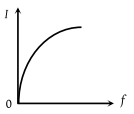In the adjoining figure, the impedance of the circuit will be:

(1) 120 ohm
(2) 50 ohm
(3) 60 ohm
(4) 90 ohm

In a series \(LCR\) circuit, which one of the following curves represents the variation of impedance \((Z)\) with frequency \((f)\)?
| 1. |  |
2. |  |
| 3. |  |
4. |  |
The variation of the instantaneous current \((I)\) and the instantaneous emf \((E)\) in a circuit are shown in the figure. Which of the following statements is correct?

| 1. | The voltage lags behind the current by \(\frac{\pi}{2}\). |
| 2. | The voltage leads the current by \(\frac{\pi}{2}\). |
| 3. | The voltage and the current are in phase. |
| 4. | The voltage leads the current by \(\pi\). |
The figure shows the variation of R, XL, and XC with frequency f in a series L, C, R circuit. Then for what frequency point, the circuit is inductive:
1. A
2. B
3. C
4. All points
An ac source of variable frequency f is connected to an LCR series circuit. Which one of the graphs in the figure represents the variation of the current I in the circuit with frequency f :
1.
2.
3.
4.
A constant voltage at different frequencies is applied across a capacitance \(C\) as shown in the figure.

Which of the following graphs accurately illustrates how current varies with frequency?
| 1. |  |
2. |  |
| 3. |  |
4. |  |
The output current versus time curve of a rectifier is shown in the figure. The average value of the output current in this case will be:

1. \(0\)
2. \(\dfrac{I_0}{2}\)
3. \(\dfrac{2I_0 }{ \pi}\)
4. \(I_0\)
The current 'i' in an inductance coil varies with time 't' according to the following graph.
Which one of the following plots shows the variations of voltage in the coil?
1.
2.
3.
4.
When an AC source of emf \(e = E_0 \sin (100t)\) is connected across a circuit, the phase difference between the emf \(e\) and the current \(i\) in the circuit is observed to be \(\frac{\pi}{4}\) as shown in the diagram. If the circuit consists only of \(RC\) or \(LC\) in series, then what is the relationship between the two elements?

| 1. | \(R=1~\text{k} \Omega, C=10 ~\mu \text{F}\) |
| 2. | \(R=1~\text{k}\Omega, C=1~\mu \text{F}\) |
| 3. | \(R=1 ~\text{k}\Omega, L=10 ~\text{H}\) |
| 4. | \(R=1 ~\text{k}\Omega, L=1~\text{H}\) |
In the diagram, two sinusoidal voltages of the same frequency are shown. What is the frequency and the phase relationship between the voltages?

| Frequency in Hz | Phase lead of \(N\) over \(M\) in radians | |
| 1. | \(0.4\) | \(-\pi/4\) |
| 2. | \(2.5\) | \(-\pi/2\) |
| 3. | \(2.5\) | \(+\pi/2\) |
| 4. | \(2.5\) | \(-\pi/4\) |
















